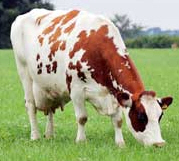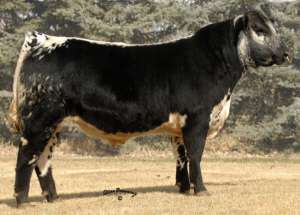



Meuse Rhine Issel
History
The Meuse Rhine Issel originates from the Netherlands and Germany. In the Netherlands, it was developed in the region of the three rivers from which it gets its name. In Germany it comes from the regions of Westfalia, Rhineland and Schleswig Holstein, and is known there as the Rotbunt. Photo courtesy of Dairy Dreams, www.dairydreams.co.uk |
In 1874 the Dutch herdbook was formed and the German breed societies followed in 1900. They were run as one breeding area across the border until 1914. During the 1920's, the Dutch bull called Sjoerd 1 925 was used extensively in the Rhineland area and played a large part in establishing a good MRI type there.
Between 1920 and 1950, Belgium, Luxembourg, France and Denmark founded their own Red and White Dual Purpose breeds, based on the Dutch and German stock.
The breed in its early years was bred as a dual purpose animal for beef and dairy, but recently breeders have concentrated on its dairy qualities although the beef is still excellent
MRI cattle were first imported into the UK and Ireland in the early 1970's and have increased in numbers to around 31500 today. Current milk pricing structures ensure a huge demand for this extremely profitable breed, where yields of 8000 to 9000kgs at 4.0% protein are not uncommon.
Characteristics
Meuse Rhine Issel are medium sized breed with a solid build, they are red and white in colour with good length and depth to the body. They are an adaptable hardy breed and have good disease resistance, they perform well on rough pasture. They are very docile in temperament, the cows have a relatively short gestation period and calve easily. The average weight for a cow is about 675 kgs with a rump height of 132 centimetres. For a bull the figures are probably around 1050 kgs and 143 centimetres respectively.Statistics
Comparative
Distribution
The Meuse Rhine Issel can be found in many parts of Europe including the Netherlands, Germany, Belgium, Luxembourg, France, Denmark, the UK and Ireland plus it has been exported to Australia, New Zealand and North America.References (the above information was cited from the following sites)
www.mri.org.uk
www.rarebreeds.co.nz


